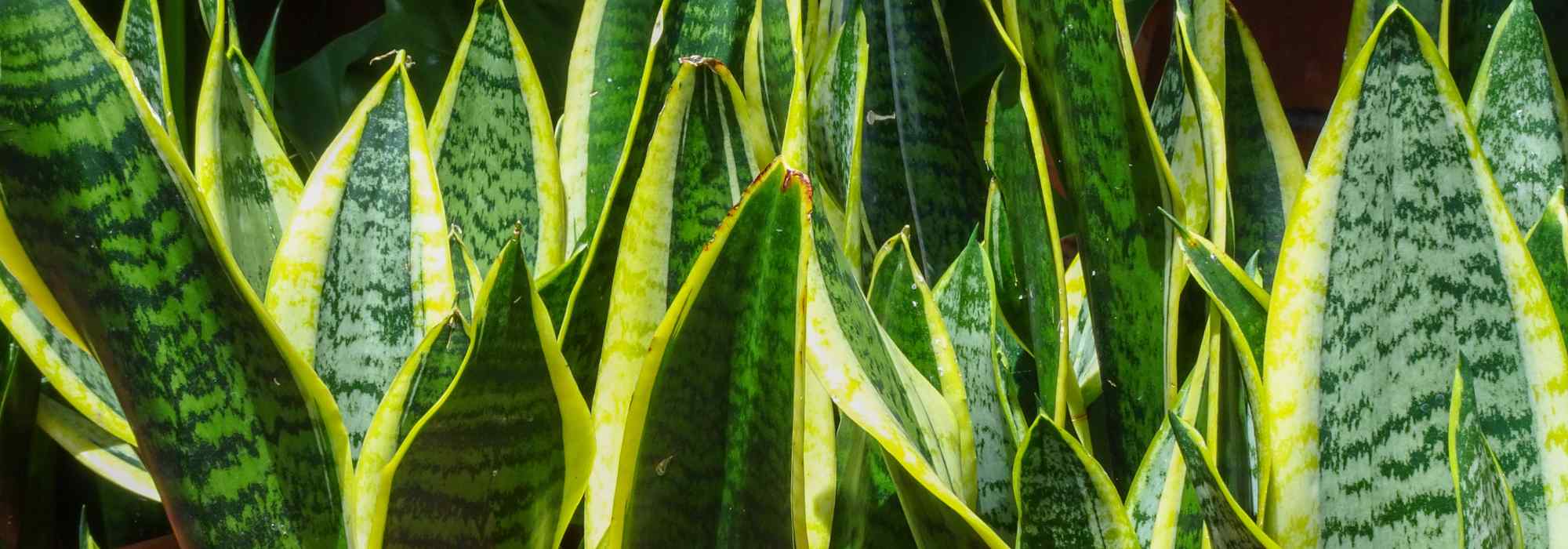
Sansevieria, Mother-in-Law's tongue : cultivation and care indoors
Contents
The Sansevieria in a few words
- The Sansevieria is a stylish and air-purifying indoor plant, known for improving air quality.
- It thrives in bright to moderate light and requires a very well-draining substrate to avoid excess moisture.
- Its care is easy: minimal watering and allowing the substrate to dry out completely between waterings are sufficient.
- An exceptionally resilient plant, it tolerates irregular watering and temperature fluctuations.
- Elegant and versatile, it blends effortlessly into any decor.
The word from our expert
The Sansevieria, or “mother-in-law’s tongue”, is an essential indoor plant for lovers of robust and elegant greenery. Long disliked due to its nickname “mother-in-law’s tongue”, this outdated and unflattering image contributed to the plant’s long-standing neglect. Today, the cultivation of Sansevieria is experiencing a real resurgence. It is a green plant perfectly suited to modern interiors thanks to its minimalist aesthetic. It is also loved for its ability to forgive even forgotten watering! Among the most popular varieties of Sansevieria, the hardy Sansevieria trifasciata and the striking Sansevieria cylindrica add a contemporary touch to any interior.
Sansevieria care is accessible to everyone, and a few simple steps are enough to avoid common problems, such as the appearance of disease on the Sansevieria’s leaves.
Over the years, Sansevieria has become a must-have choice, thanks to its many benefits, including its ability to purify the surrounding air. Easy to propagate, it also offers the opportunity to expand your indoor plant collection in a simple and fun way, as taking a Sansevieria cutting is very straightforward.
Discover our Sansevieria collection now and give your home a resilient and air-purifying plant!
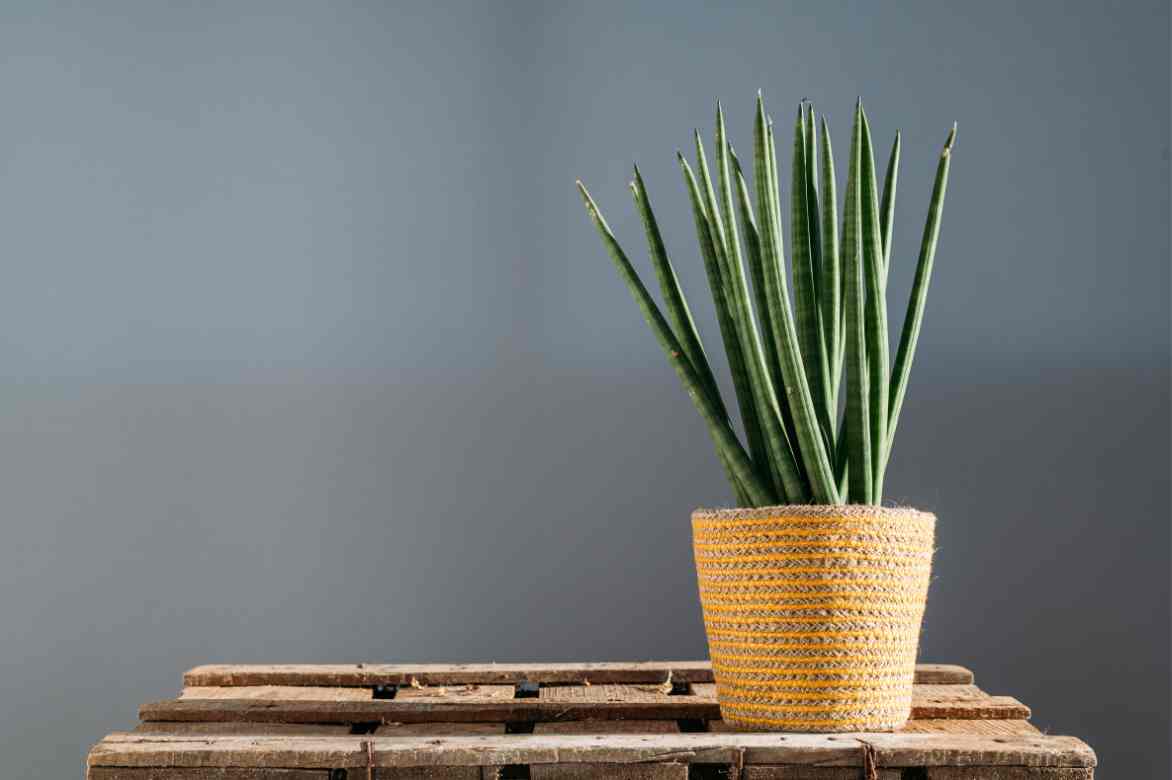
Sansevieria cylindrica
Botany and description
Botanical data
- Latin name Sansevieria
- Family Asparagaceae
- Common name Mother-in-law's tongue, snake plant, sansevieria
- Flowering rare indoors
- Height From 30 cm to 1.50 m depending on the variety
- Exposure Bright to moderate light, tolerates low light
- Soil type Very well-draining mix, universal potting soil lightened with perlite or sand
- Hardiness Frost-sensitive
The Sansevieria, often nicknamed “mother-in-law’s tongue” or “snake plant” in French, belongs to the Asparagaceae family, just like Dracaena and Asparagus. It owes its popular nickname to its long, rigid, and sharp leaves, seen as a humorous metaphor for the talkative or sharp reputation traditionally associated with mothers-in-law.
Native mainly to tropical Africa and some regions of South Asia, this plant grows naturally in arid and rocky environments, where conditions are often extreme with poor soils and rare rainfall. In our latitudes, Sansevieria is grown indoors, as it cannot tolerate cold temperatures and lacks the hardiness to survive outdoors. Its ability to withstand drought, tolerate irregular care, and thrive in low-light environments makes it a highly appreciated houseplant.
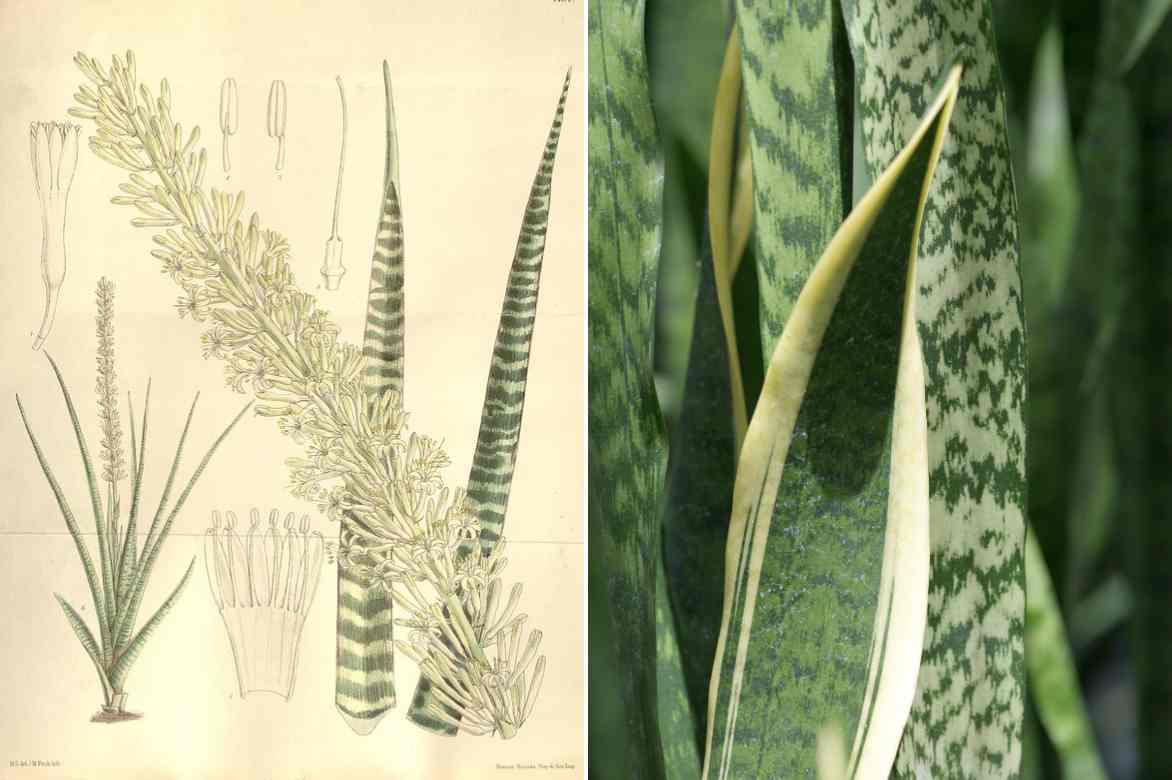
Botanical plate: Sansevieria roxburghiana, and on the right, the remarkable foliage of the common species, Sansevieria trifasciata
The Sansevieria genus includes around 70 species, although some recent classifications now integrate it into the Dracaena genus. Among the most cultivated are Sansevieria trifasciata, with long, upright, marbled green leaves (notably the cultivars ‘Laurentii’ with golden edges, ‘Moonshine’ with silvery foliage, and ‘Zeylanica’ with a darker pattern), Sansevieria cylindrica, recognizable by its cylindrical and rigid leaves, and Sansevieria masoniana, remarkable for its large, wide, and undulating leaves nicknamed “elephant’s ear.”
Sansevieria is a perennial herbaceous plant with an upright habit, sometimes spreading depending on the species, often forming dense clumps. Its root system is fasciculate, thickened, complemented by underground rhizomes, either running or swollen, which ensure vegetative propagation. Sansevieria exhibits slow growth, characteristic of its adaptation to arid environments. Under good growing conditions, the plant may produce a few new leaves per year, but its development remains modest compared to many other houseplants. This slow growth gives Sansevieria exceptional longevity and reduces the frequency of repotting.
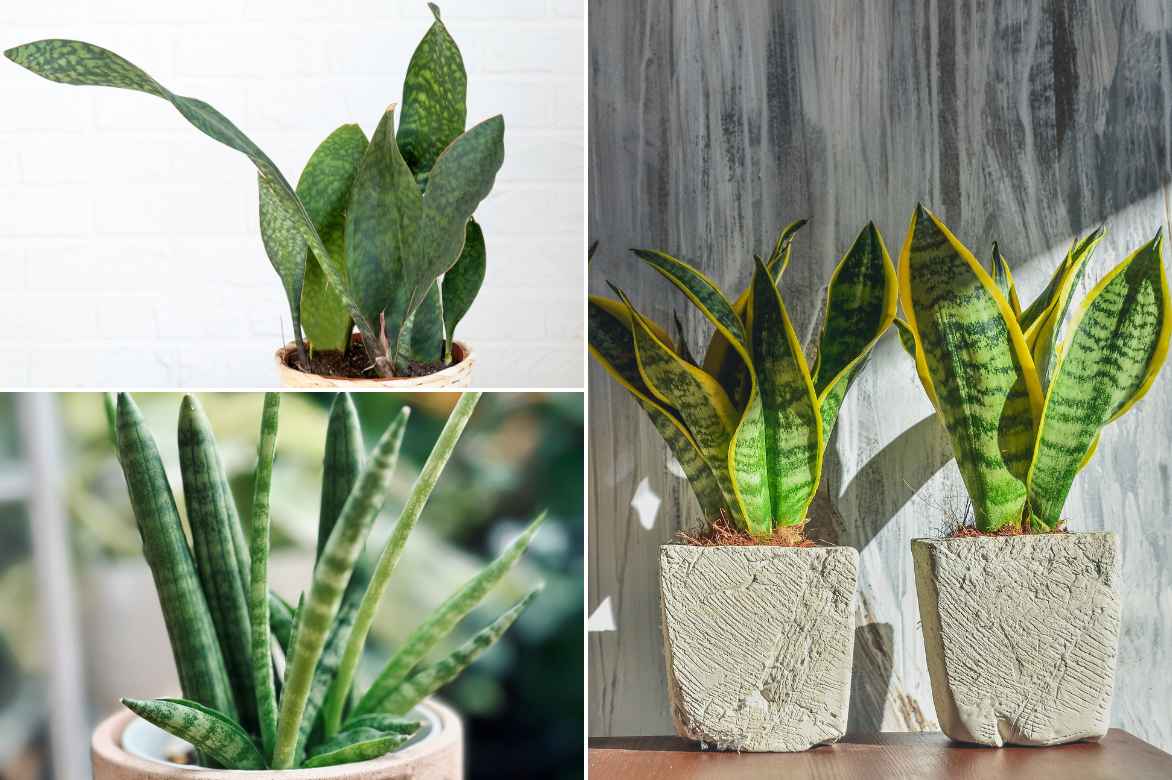
Sansevieria masoniana, Sansevieria cylindrica, and on the right Sansevieria trifasciata
The plant can reach between 30 centimetres and over a metre in height, depending on the species and growing conditions. It does not develop a distinct aerial stem; the leaves emerge directly from the rhizome, arranged in basal rosettes. The foliage, particularly fleshy and tough, is generally upright, sometimes trailing, and presents very variable forms, ranging from flat and lanceolate to cylindrical. The leaf surface is often marbled or striated with dark green, light green, or silvery grey patterns, sometimes edged with a coloured margin.
The flowering, relatively rare in indoor cultivation, is borne by a floral spike that emerges directly from the base of the plant, between the leaves, from an axillary bud. It appears as a simple or slightly branched inflorescence, composed of numerous small tubular flowers. The flowers, generally greenish-white to creamy-white, sometimes slightly pinkish, emit a sweet fragrance particularly noticeable in the late afternoon. Each flower has a narrow tube flaring into six pointed and outwardly curved lobes, with six protruding stamens and a long, visible style. Fruiting, infrequent in our latitudes, results in the formation of a globular berry, orange to reddish in colour, containing one to three seeds.

Flowering indoors remains very rare
Mother-in-law’s tongue (Sansevieria) naturally helps regulate ambient humidity indoors, thus providing additional comfort for the skin, eyes, and respiratory tract. It is also recognised for its ability to absorb certain volatile organic compounds, notably formaldehyde and benzene, thereby helping to improve indoor air quality, especially in poorly ventilated environments.
Sansevieria is associated with several cultural traditions. In South Korea, it is often given during professional meetings or inaugurations, symbolising prosperity, perseverance, and respect. In Africa, its leaves provide strong fibres, traditionally used for making baskets, ropes, and artisanal objects.
Popular species and varieties
Planting Sansevieria Indoors
Where to Place It Indoors?
The Sansevieria should be placed in a room with bright to moderate light. It tolerates low light, making it adaptable to spots further from windows or in less exposed areas, such as hallways or inner offices. However, to optimise its growth and maintain the intensity of its foliar colours, good light is preferable. A position behind a sheer curtain or near an east or west-facing window is ideal. Under prolonged insufficient light, the plant will significantly slow its growth, its leaves may stretch (etiolation), and its patterns may become less pronounced. On the other hand, direct sunlight, especially during the hottest hours, can cause foliar burns.
The Sansevieria thrives in an ambient temperature between 15 and 30 °C and is highly resistant to common thermal variations indoors. It prefers an air humidity level between 30 and 50% and does not require any specific increase in humidity.
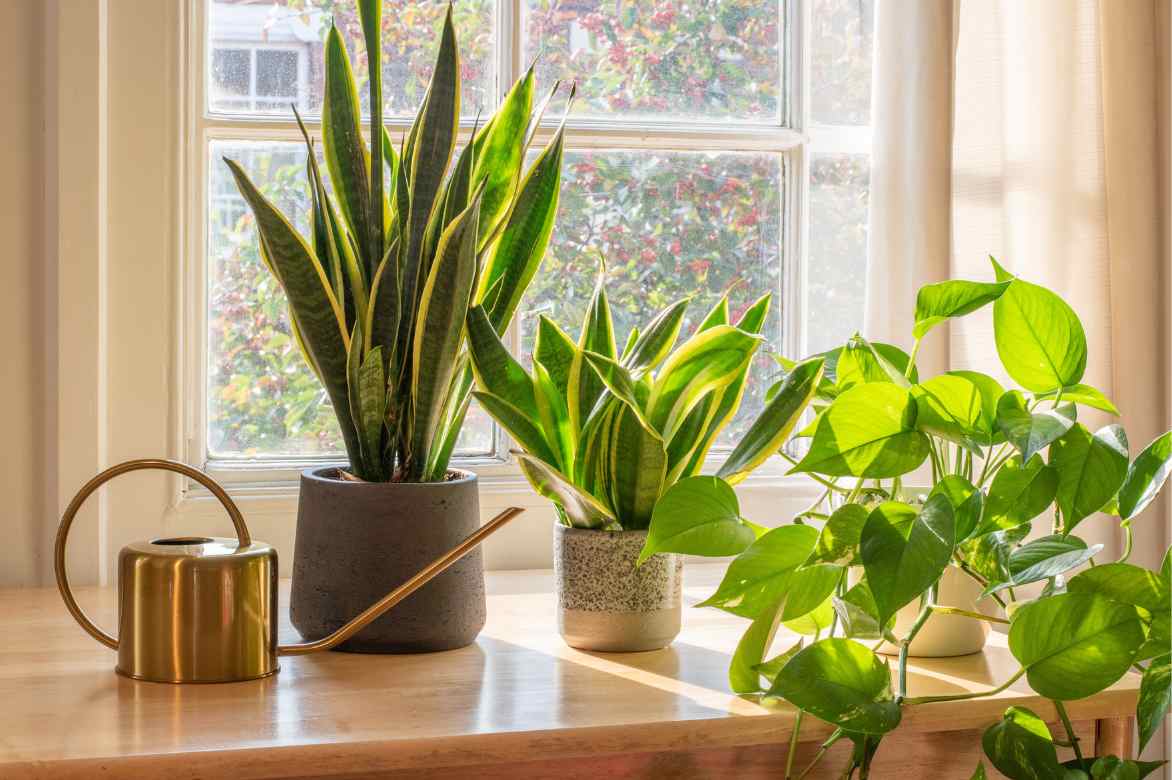
When to Plant It?
Planting can be done year-round indoors. However, spring is the ideal time, as the plant enters active growth, promoting rooting and adaptation to a new container.
How to Plant Mother-in-Law’s Tongue in a Pot
The Pot
It is essential to choose a pot with drainage holes at the bottom to avoid water stagnation, as the Sansevieria is particularly sensitive to excess moisture. A drainage layer, made of clay pebbles or gravel, should be placed at the bottom of the pot to prevent water retention.
The Substrate
The substrate should be light and perfectly draining to prevent the risk of root rot. Here is an ideal substrate composition for planting a Sansevieria:
- 50% indoor plant compost or a good universal compost
- 30% perlite to improve lightness and drainage
- 20% composted pine bark to promote soil aeration
Planting
- Prepare the substrate.
- Place the plant, positioning the collar just above the substrate level.
- Fill the gaps without compacting too much to preserve the soil’s airy structure.
- Water moderately after planting, then allow it to dry completely before watering again.
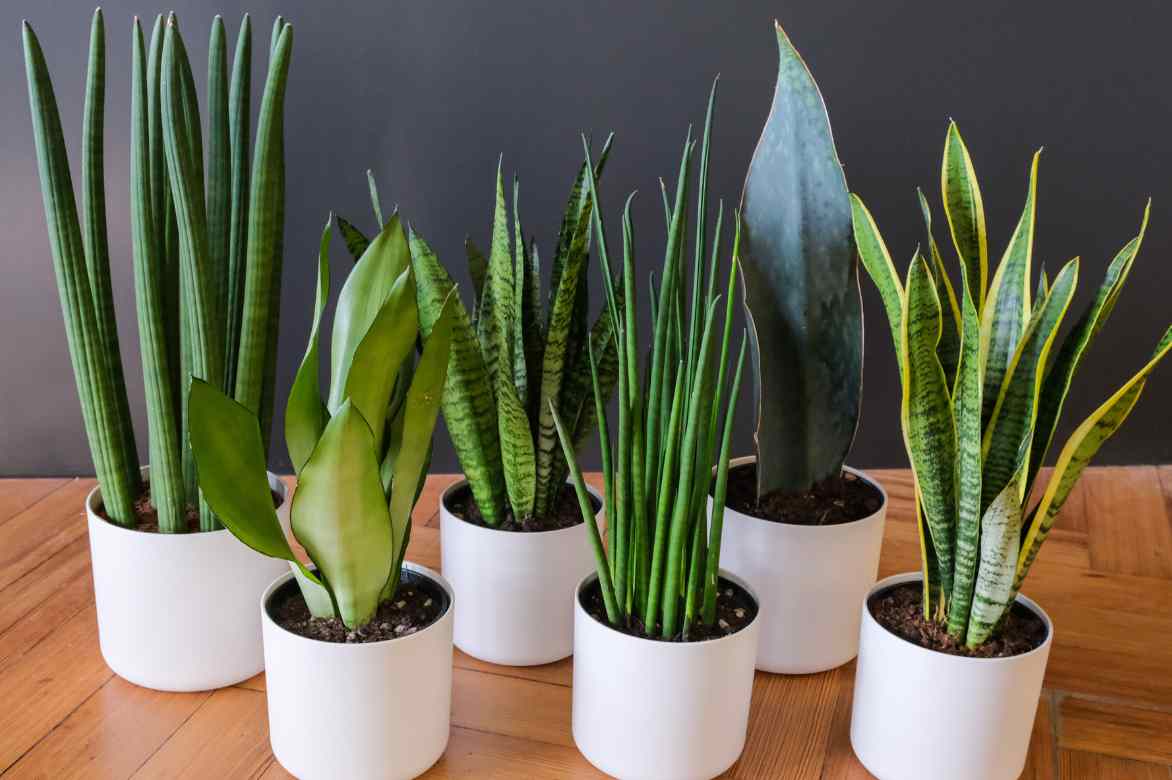
The pots do not need to be very large
How to care for the mother-in-law's tongue plant?
The Sansevieria is a low-maintenance houseplant, perfect for those seeking an easy-to-care-for plant that requires minimal intervention. Proper care ensures its longevity and the beauty of its foliage.
Watering
The Sansevieria should be watered sparingly. It is essential to allow the compost to dry out completely between waterings to avoid the risk of root rot. In spring and summer, watering every two to three weeks is sufficient, depending on the ambient temperature and light exposure. In autumn and winter, the frequency should be significantly reduced: a monthly watering, or even less in cool, dry conditions, is enough. This plant tolerates missed waterings very well, thanks to its ability to store water in its thick leaves.
Misting is optional: the Sansevieria tolerates low ambient humidity and does not require additional moisture.
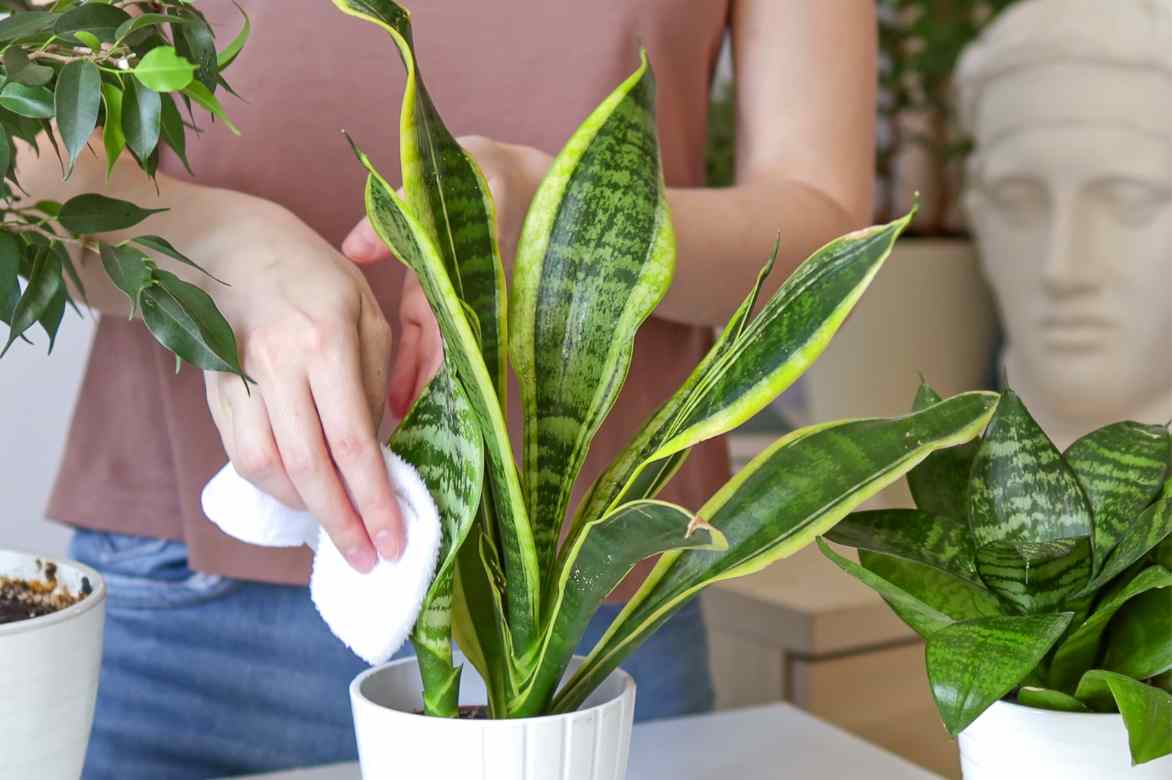
Regularly cleaning the foliage helps the plant with its photosynthesis
Fertilisation
Fertilisation should remain moderate. An application of a liquid fertiliser for houseplants or cacti, diluted to half the recommended dose, can be given once a month in spring and summer. No fertilisation is needed in autumn and winter, periods of dormancy when the plant naturally slows its growth.
Pruning
Pruning the Sansevieria is rarely necessary. It is limited to removing damaged, wilted, or dry leaves. These should be cut off at the base with a clean, sharp tool to avoid unnecessary injury and prevent the risk of disease.
Repotting
Repotting should be planned every two to three years, or when the plant becomes too cramped and the roots or rootstocks deform the pot. It is recommended to repot in spring, choosing a container slightly larger than the previous one and completely renewing the compost with a very well-draining mix. After repotting, wait a few days before resuming watering to allow the roots to heal.
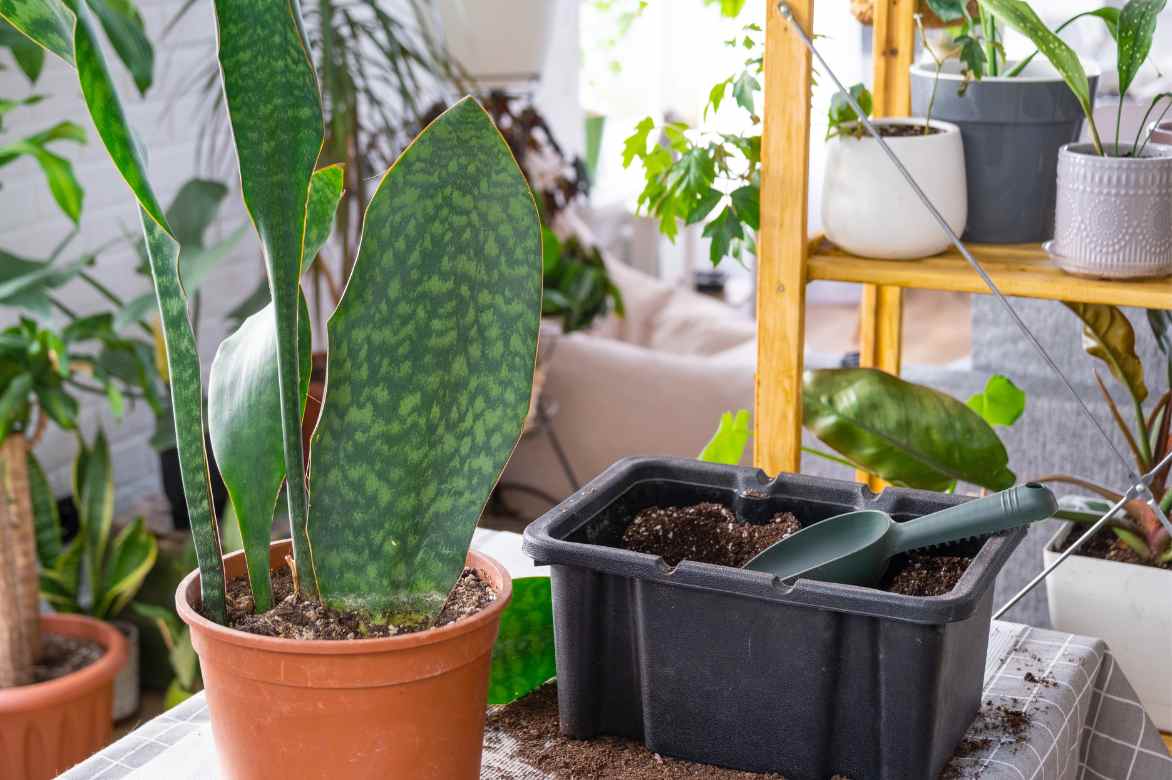
Repotting a Sansevieria masoniana
Sansevieria pests and diseases
The Sansevieria is a generally robust plant, rarely prone to diseases and parasitic attacks under normal growing conditions. However, certain ailments can appear, especially when the plant is weakened by excess moisture, poor drainage, or an environment that is too dark.
Parasites
Mealybugs
Mealybugs are the most frequently encountered parasites on Sansevieria. They mainly attach themselves to the leaf bases and form small white, cottony clusters. By feeding on the sap, they slow down growth and gradually weaken the plant.
Natural solution: Thoroughly clean the infested areas with a soft cloth soaked in soapy water, then apply a neem essential oil solution to prevent their reappearance. Weekly treatment may be necessary until they are completely gone. To learn more: Mealybugs: Identification and Natural Treatments.
Red Spider Mites
Red spider mites mainly appear in hot and dry conditions. They cause punctual yellowing of the foliage, sometimes followed by leaf drying. Their presence is often betrayed by fine webs between the leaves.
Natural solution: Temporarily increase humidity around the plant by misting the foliage with water (without excess) and wiping the leaves with a damp cloth. Additionally, spray a nettle liquid manure decoction or a diluted neem oil solution.
Sansevieria Diseases
Root Rot
Root rot is the most common disease in Sansevieria. It is usually caused by overwatering or insufficiently draining soil. Symptoms include leaves softening at the base, turning dark, watery, and sometimes emitting an unpleasant odour. The progression is rapid and can lead to the death of the plant if no action is taken.
Natural solution: Remove the plant from the pot, eliminate all soft and blackened parts with a disinfected tool, then let the healthy roots air-dry for 24 to 48 hours. Repot in a perfectly draining new substrate and reduce watering.
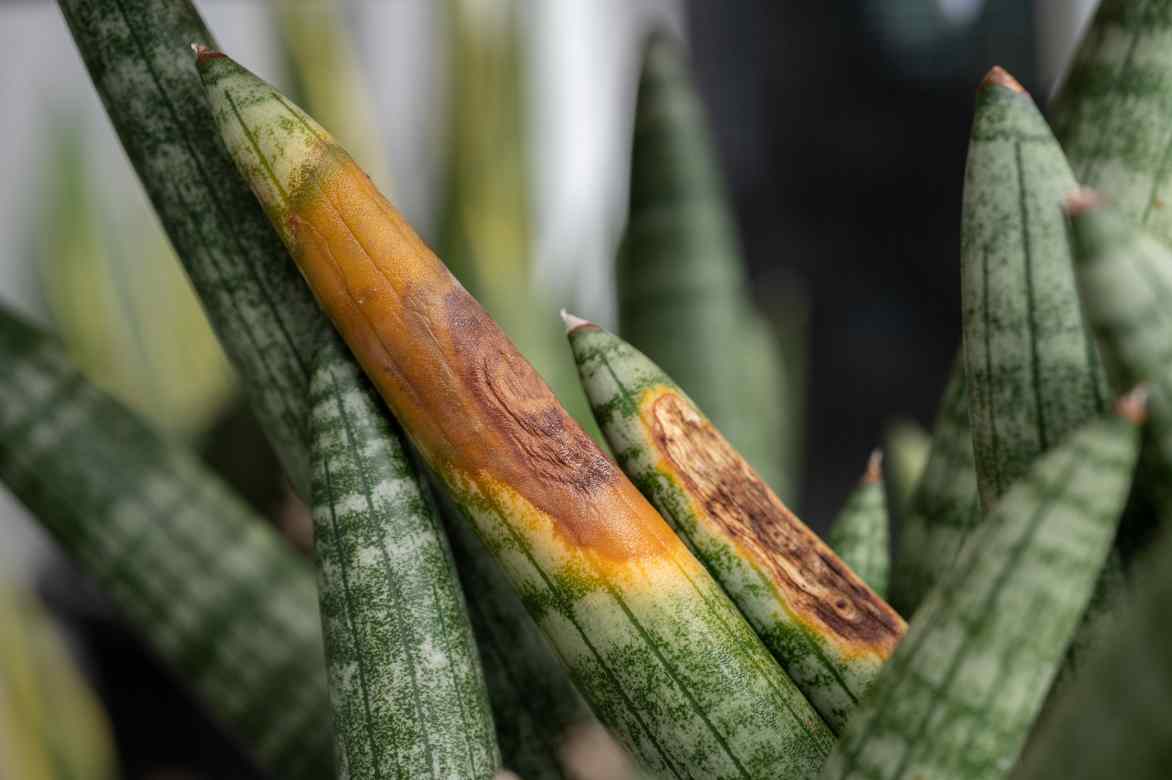
Overwatering often causes spots on the foliage
Collar Rot
Collar rot affects the base of the leaves at the point of attachment to the rootstock, often due to repeated water splashes on the rosette or stagnant moisture. Affected leaves become soft and detach easily.
Natural solution: Remove affected leaves immediately with clean pruning shears and stop all watering for several days. Improve air circulation around the plant and, if necessary, replant in dry substrate to prevent further contamination.
General Prevention
- Control watering: Water moderately and only when the substrate is completely dry.
- Choose the right substrate: Use a very well-draining mix to avoid water stagnation around the roots.
- Provide good exposure: Place the Sansevieria in a bright spot, without direct scorching sunlight, while avoiding overly dark areas.
- Monitor regularly: Inspect the foliage to quickly detect signs of parasites, yellowing, or rot.
- Maintain good hygiene: Remove damaged leaves and clean the pot and immediate environment to limit the risk of disease.
Propagation of Sansevieria
The Sansevieria can be propagated in two main ways: by leaf cutting and by division of the rootstock. Each method has its advantages depending on the desired outcome.
Propagating Sansevieria by Cutting
Leaf cutting is the most common and simplest method to propagate a Sansevieria. It is best done in spring or summer, when the plant is in its active growth phase.
- Select a healthy, well-formed leaf.
- Cut it into sections of 5 to 10 cm in length using a clean, sharp tool.
- Allow the leaf segments to air-dry for 24 to 48 hours to prevent rotting.
- Plant the segments vertically in a light, well-draining substrate (universal compost mixed with sand or perlite), ensuring the base of the leaf is at the bottom.
- Place the cuttings in a bright spot, away from direct sunlight, at a temperature between 20 and 25 °C.
- Water lightly and keep the substrate slightly moist until roots appear, usually within a few weeks.
Note: Propagation by leaf cutting may cause variegated varieties with yellow or white margins to revert to entirely green young plants.
Propagation by Division of Rootstock
Division of the rootstock is the most reliable method to preserve all the characteristics of the parent plant, including variegation.
- Carefully remove the plant from its pot.
- Separate the rootstocks using a clean knife, ensuring each segment has at least one rosette of leaves and some roots.
- Allow the rootstock sections to dry for 24 hours to heal the wounds.
- Replant each division in a suitable pot filled with a light, well-draining substrate.
- Water lightly after a few days to encourage rooting.
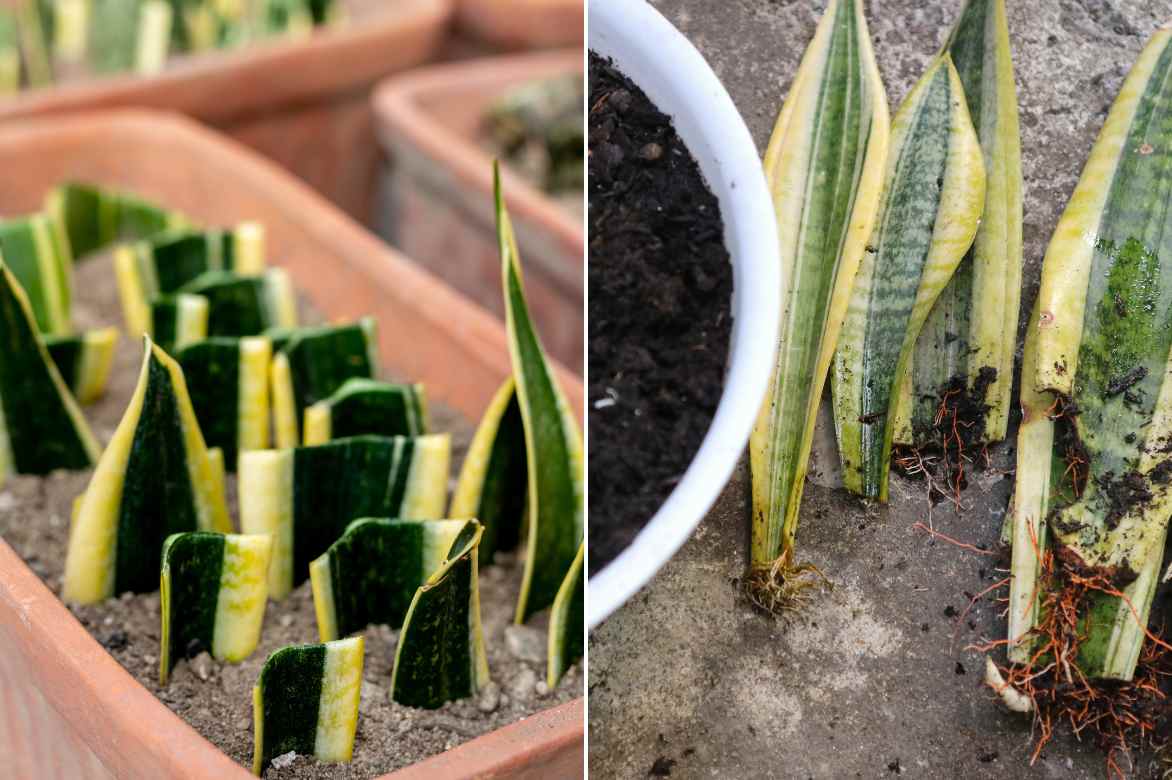
Propagation by cutting or division of Sansevieria
Benefits of Sansevieria
Beyond its ornamental appeal, the Sansevieria is used in certain traditional medicines. Its leaves are used externally, as a poultice. In Malaysia and Bangladesh, they are employed to relieve mild pain and reduce fever. In Sri Lanka, the plant is traditionally used to treat certain inflammations and promote wound healing.
How to incorporate Sansevieria into your home?
With its graphic habit and clean lines, the Sansevieria is the perfect plant to add a contemporary and elegant touch to any room in the house. Highly versatile, it naturally finds its place in an entrance hall, where it instantly creates an impression of verticality and rigour. It is also ideal in a modern living room or office, where its structured silhouette enhances a minimalist or industrial style. In a bedroom, it brings a soothing note and, as an added bonus, it continues to produce oxygen during the night.
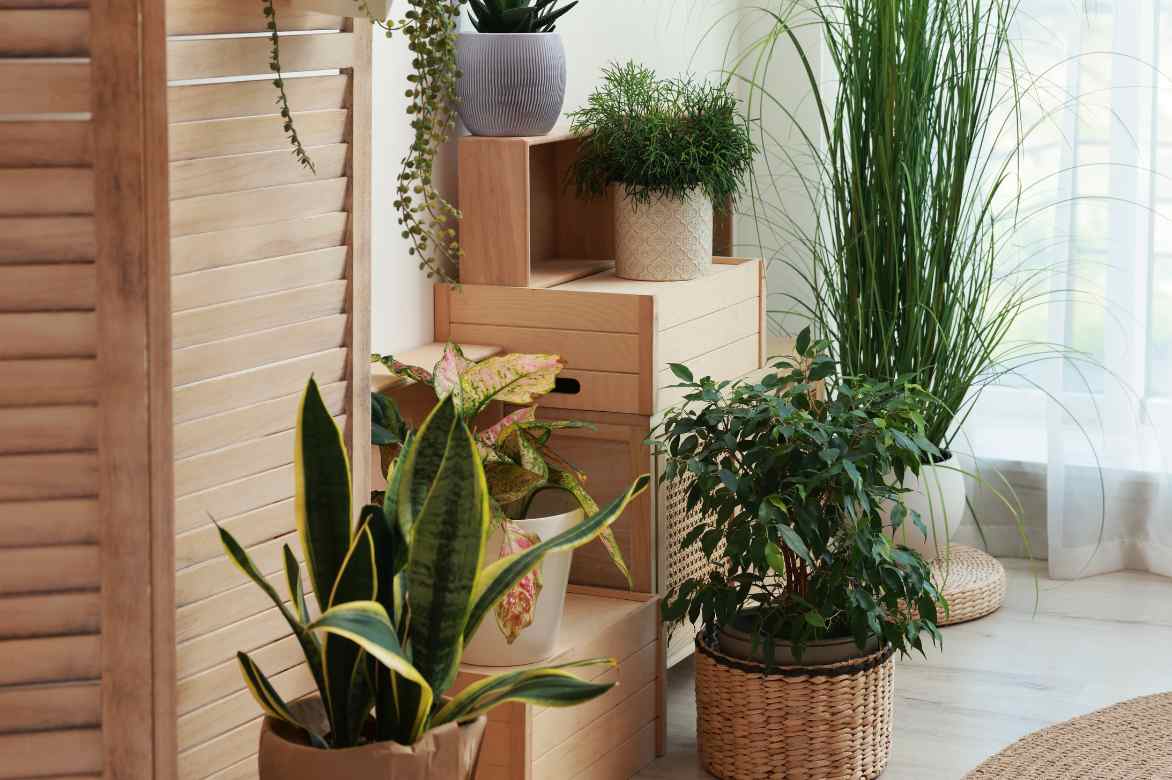
For an even more striking effect, don’t hesitate to play with accumulation: several Sansevierias of different sizes grouped together in raw terracotta or glazed ceramic pots create a chic yet natural ensemble. It pairs particularly well with other houseplants featuring contrasting shapes: a Ficus lyrata for its broad foliage, a Zamioculcas zamiifolia for its sculptural appearance, or even a Monstera deliciosa for its lush vibe. The combination of their varied textures adds depth and subtly enlivens the space.
Whether you choose a large standalone specimen in a bright corner or a composition of matching pots, the Sansevieria adapts to all styles and instantly adds character to your interior. Go ahead and indulge!
Also see
→Discover our wide range of houseplants.
→Our decorative foliage houseplants and our flowering houseplants.
→Many books on houseplants.
Frequently asked questions
-
Why are the leaves of my Sansevieria turning yellow?
Yellowing of the leaves is often due to overwatering or poor drainage; it is essential to let the soil dry out completely between waterings.
-
When should you water a Sansevieria?
The Sansevieria should only be watered when the substrate is completely dry, approximately every two to three weeks in summer, and once a month in winter.
-
Why does the Sansevieria leaf curl?
A leaf that folds is often a sign of prolonged water shortage or stress caused by excessive moisture weakening the internal tissues.
- Subscribe!
- Contents
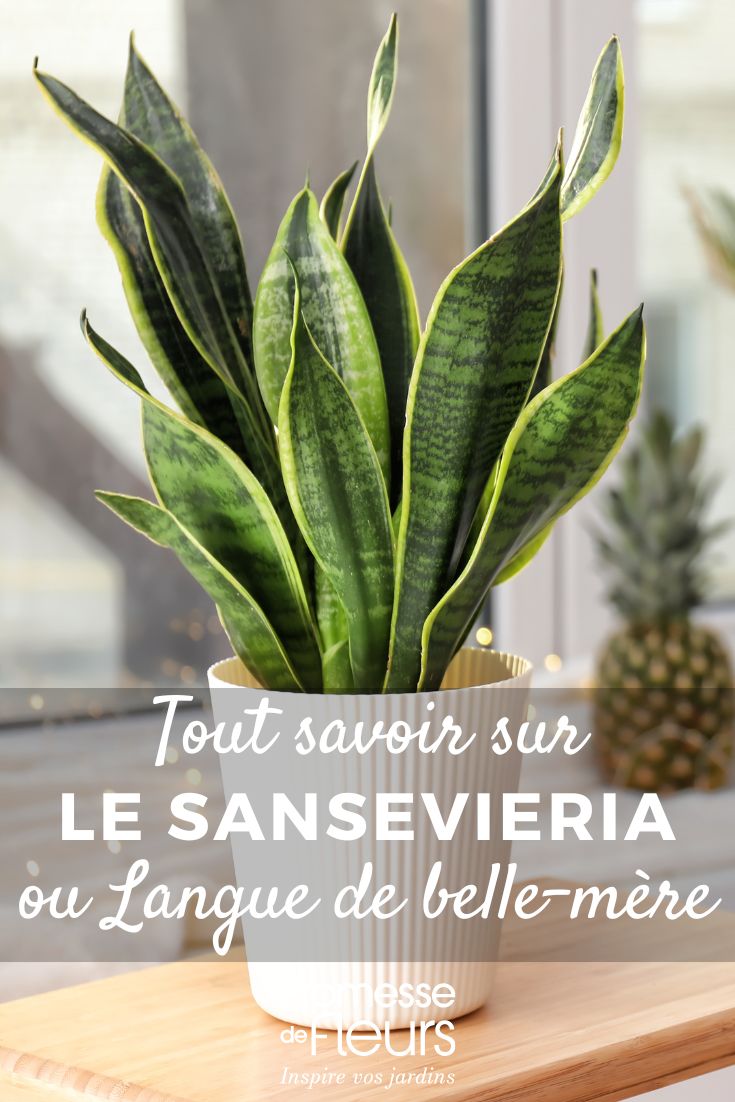































Comments